1996 BUICK PARK AVENUE engine
[x] Cancel search: enginePage 3 of 388
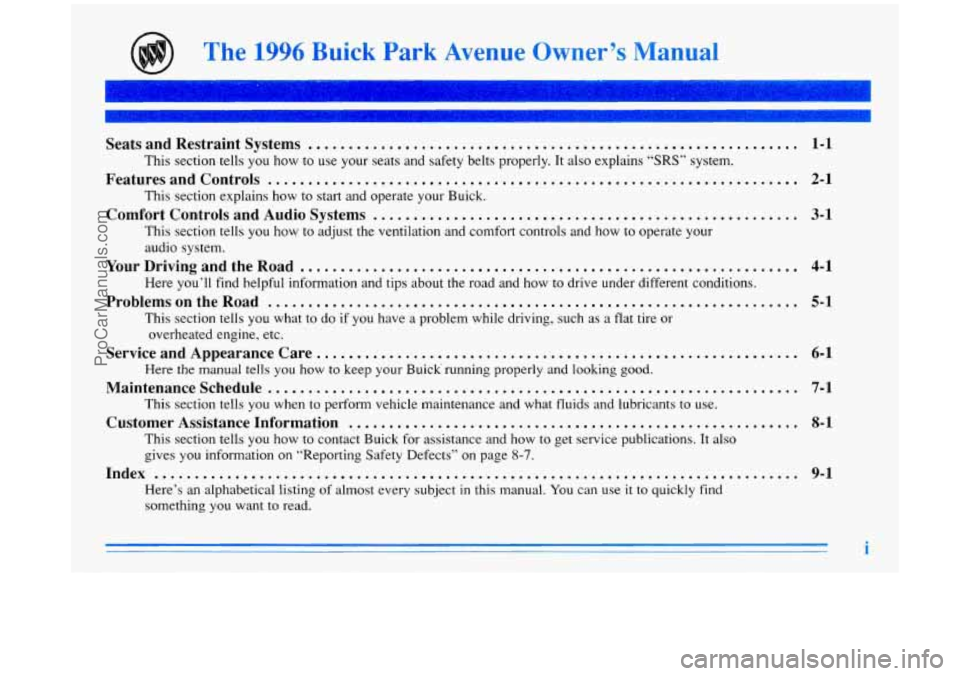
The 1996 Buick Park Avenue Owner’s Manual
Seats and Restraint Systems ............................................................. 1-1
Features and Controls .................................................................. 2-1
Comfort Controls and Audio Systems ..................................................... 3-1
This section tells you how to use your seats and safety belts properly. It also explains “SRS” system.
This section explains how to start and operate your Buick.
This section tells you how to adjust the ventilation and comfort controls and how to operate your
audio system.
Here you’ll find helpful information and tips about the road and how to drive under different conditions.
YourDrivingandtheRoad .............................................................. 4-1
ProblemsontheRoad .................................................................. 5-1
This section tells you what to do if you have a problem while driving, such as a flat tire or
overheated engine, etc.
Here the manual tells you how to keep your Buick’ running properly
and looking good.
This section tells you when to perform vehicle maintenance and what fluids and lubricants to use.
ServiceandAppearanceCare ............................................................ 6-1
Maintenanceschedule .................................................................. 7-1
Customer Assistance Information ........................................................ 8-1
This section tells you how to contact Buick for assistance and how to get service publications. It also
gives you information
on “Reporting Safety Defects” on page 8-7.
Index ........................................................................\
........ 9-1
Here’s an alphabetical listing of almost every subject in this manual. You can use it to quickly find
something you want
to read.
i
ProCarManuals.com
Page 6 of 388
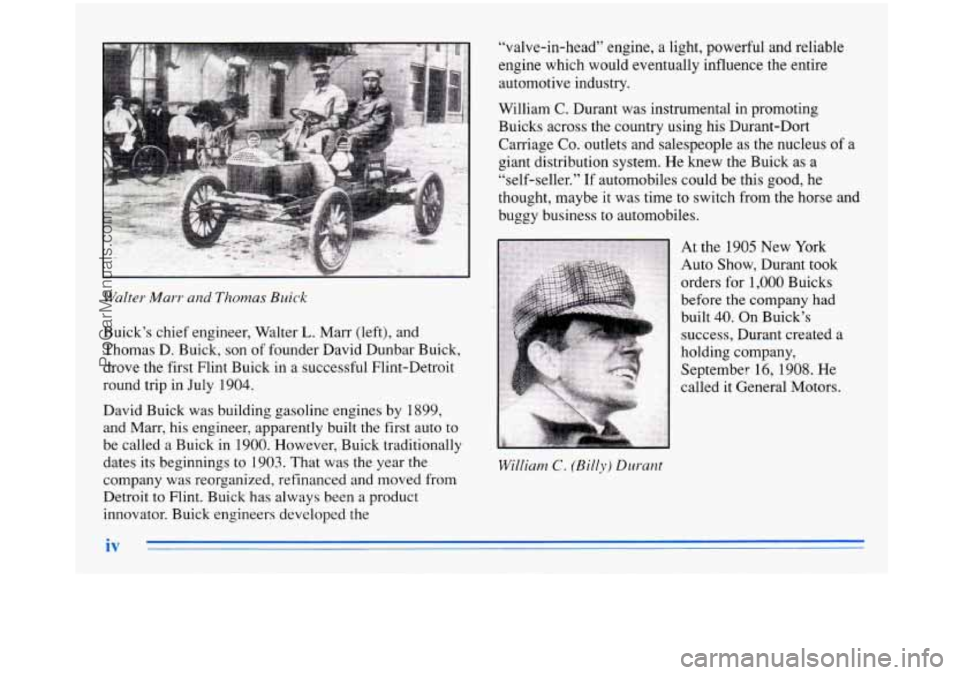
Walter Maur and Thomas Buick
Buick’s chief engineer, Walter L. Marr (left), and
Thomas D. Buick, son of founder David Dunbar Buick,
drove the first Flint Buick in a successful Flint-Detroit
round trip in July 1904.
David Buick was building gasoline engines by 1899,
and Marr, his engineer, apparently built the first auto to
be called a Buick in 1900. However, Buick traditionally
dates its beginnings to 1903. That was the year the
company was reorganized, refinanced and moved from
Detroit to Flint. Buick has always been a product
innovator. Buick engineers developed the “valve-in-head” engine, a
light, powerful and reliable
engine which would eventually influence the entire
automotive industry.
William C. Durant was instrumental in promoting
Buicks across the country using his Durant-Dort
Carriage
Co. outlets and salespeople as the nucleus or a
giant distribution system. He knew the Buick as a
“self-seller.”
If automobiles could be this good, he
thought, maybe
it was time to switch from the horse and
buggy business to automobiles.
1.
At the 1905 New York
Auto Show, Durant took
orders for 1,000 Buicks
before the company had
built
40. On Buick’s
success, Durant created
a
holding company,
September 16, 1908. He
called it General Motors.
William C. (Billy) Duvant
ProCarManuals.com
Page 7 of 388
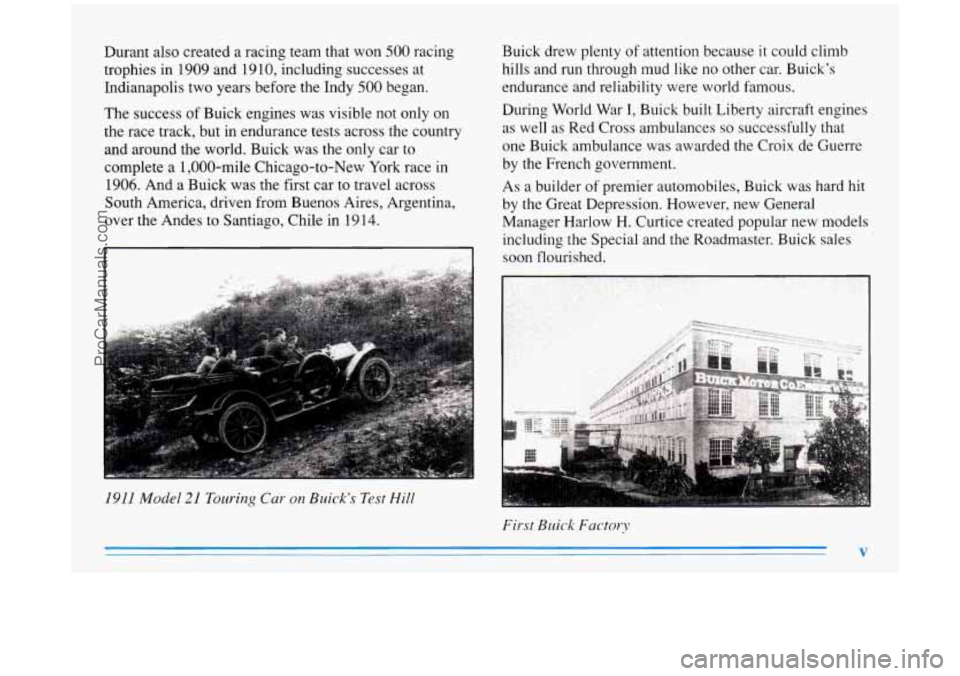
Durant also created a racing team that won 500 racing
trophies in 1909 and 19
10, including successes at
Indianapolis two years before the Indy
500 began.
The success of Buick engines was visible not only on
the race track, but in endurance tests across the country
and around the world. Buick was the only car to
complete a 1,000-mile Chicago-to-New York race in
1906. And
a Buick was the first car to travel across
South America, driven from Buenos Aires, Argentina,
over the Andes to Santiago, Chile in 1914.
I9II Model 21 Touring Car on Buick’s Test Hill
Buick drew plenty of attention because it could climb
hills and run through mud like
no other car. Buick’s
endurance and reliability were world famous.
During World War I, Buick built Liberty aircraft engines
as well as Red Cross ambulances so successfully that
one Buick ambulance was awarded the Croix de Guerre
by the French government.
As a builder of premier automobiles, Buick was hard hit
by the Great Depression. However, new General
Manager Harlow
H. Curtice created popular new models
including the Special and the Roadmaster. Buick sales
soon flourished.
I :
First Buick Factory
V
ProCarManuals.com
Page 8 of 388
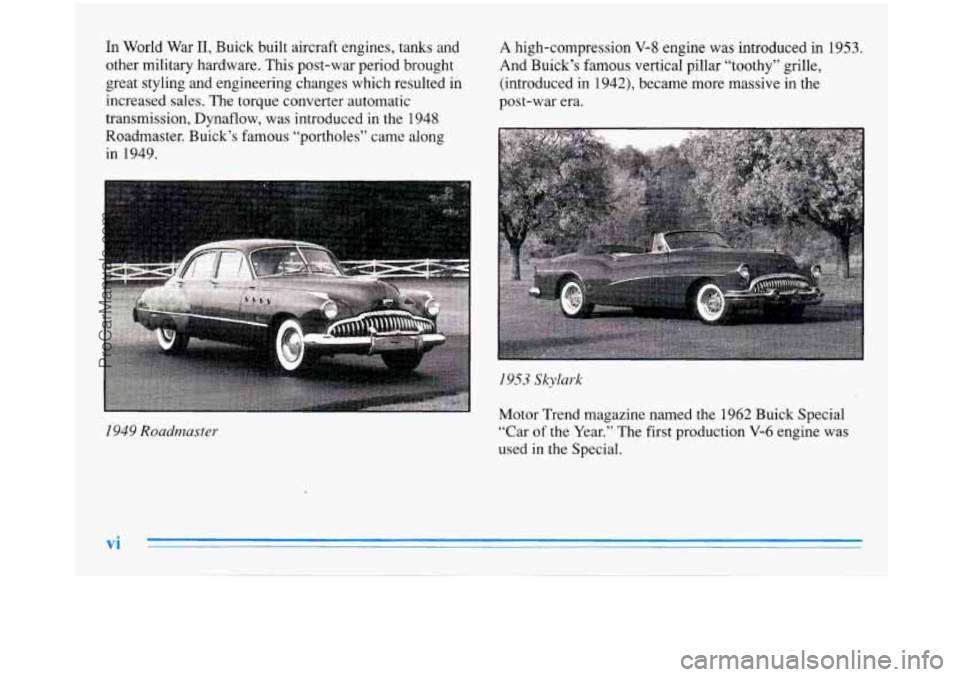
In World War 11, Buick built aircraft engines, tanks and
other military hardware. This post-war period brought
great styling and engineering changes which resulted in
increased sales. The torque converter automatic
transmission, Dynaflow, was introduced in the 1948
Roadmaster. Buick’s famous “portholes” came along
in 1949.
1949 Roadmaster
vi
A high-compression V-8 engine was introduced in 1953.
And Buick’s famous vertical pillar “toothy” grille,
(introduced in
1942)’ became more massive in the
post-war
era.
I953 Skylark
Motor Trend magazine named the 1962 Buick Special
“Car
of the Year.” The first production V-6 engine was
used
in the Special.
ProCarManuals.com
Page 12 of 388
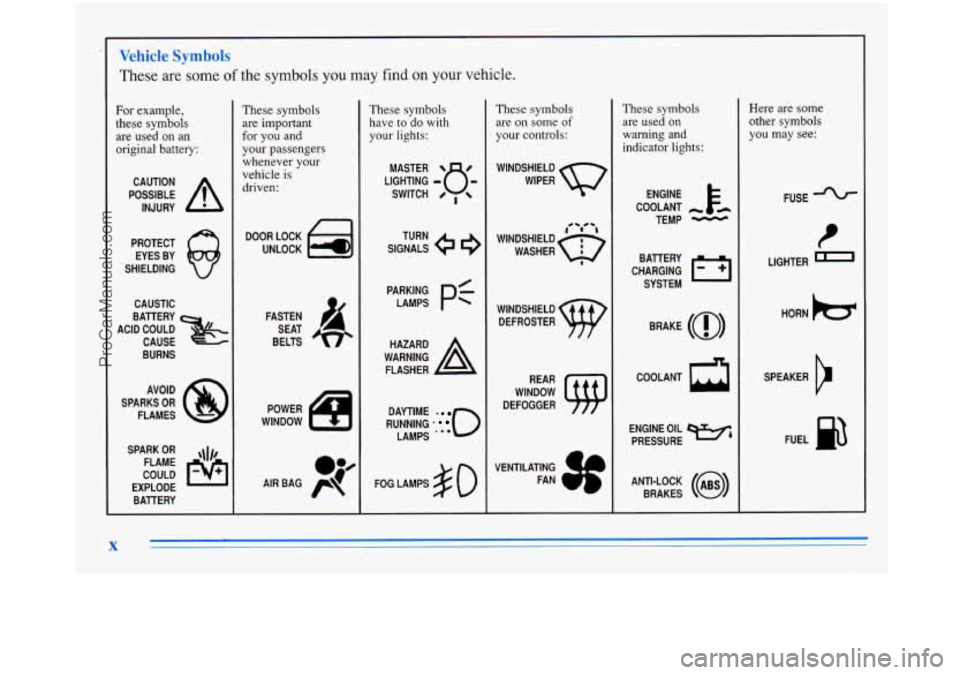
Vehicle Symbols
These are some of the symbols you may find on your vehicle.
For example,
these symbols
are used on an
original battery:
POSSIBLE A
CAUTION
INJURY
PROTECT EYES BY
SHIELDING
CAUSTIC
BURNS AVOID
SPARKS
OR
FLAMES
SPARK
OR ,\I/,
COULD FLAME
EXPLODE BATTERY
These symbols
are important
for you and
your passengers
whenever your
vehicle is driven:
DOOR LOCK
UNLOCK
FASTEN SEAT
BELTS
POWER
WINDOW
These symbols
have to do with
your lights:
SIGNALS e e
TURN
WARNING
A
HAZARD
FLASHER
RUNNING
0
DAYTIME -
LAMPS '**
FOG LAMPS $0
These symbols
are on
some of
your controls:
WINDSHIELD
WIPER
WINDSHIELD DEFROSTER
WINDOW
DEFOGGER
VENTILATING FAN
These symbols are used
on
warning and
indicator lights:
COOLANT
TEMP
-
CHARGING I-1
BATTERY
SYSTEM
BRAKE
(0)
ENGINE OIL e,
PRESSURE
ANTI-LOCK
(@)
BRAKES
Here are some
other symbols you may see:
FUSE
I
LIGHTER I
HORN h=r
SPEAKER
b
FUEL n3
X
ProCarManuals.com
Page 63 of 388
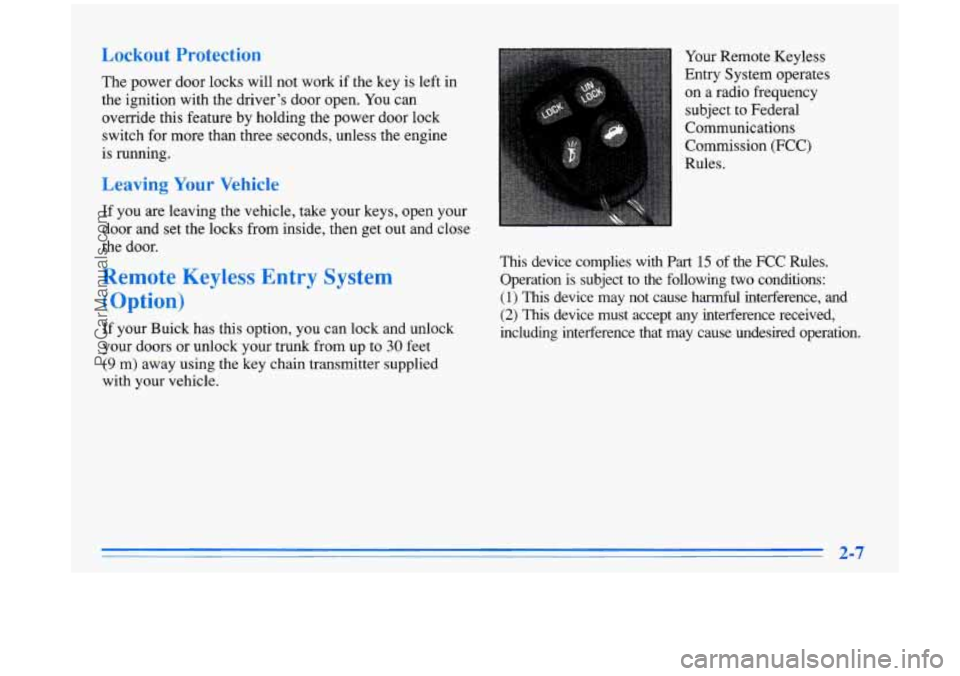
Lockout Protection
The power door locks will not work if the key is left in
the ignition with the driver’s door open. You can
override this feature by holding the power door lock
switch for more than three seconds, unless the engine
is running.
Leaving Your Vehicle
If you are leaving the vehicle, take your keys, open your
door and set the locks from inside, then get out and close
the door.
Remote Keyless Entry System
(Option)
If your Buick has this option, you can lock and unlock
your doors or unlock your trunk from up to
30 feet
(9 m) away using the key chain transmitter supplied
with your vehicle. Your
Remote Keyless
Entry System operates
on a radio frequency
subject
to Federal
Communications
Commission (FCC)
Rules.
This device complies with Part 15 of the FCC Rules.
Operation is subject to the
following two conditions:
(1) This device may not cause harmful interference, and
(2) This device must accept any interference received,
including interference that may cause undesired operation.
2-7
ProCarManuals.com
Page 70 of 388
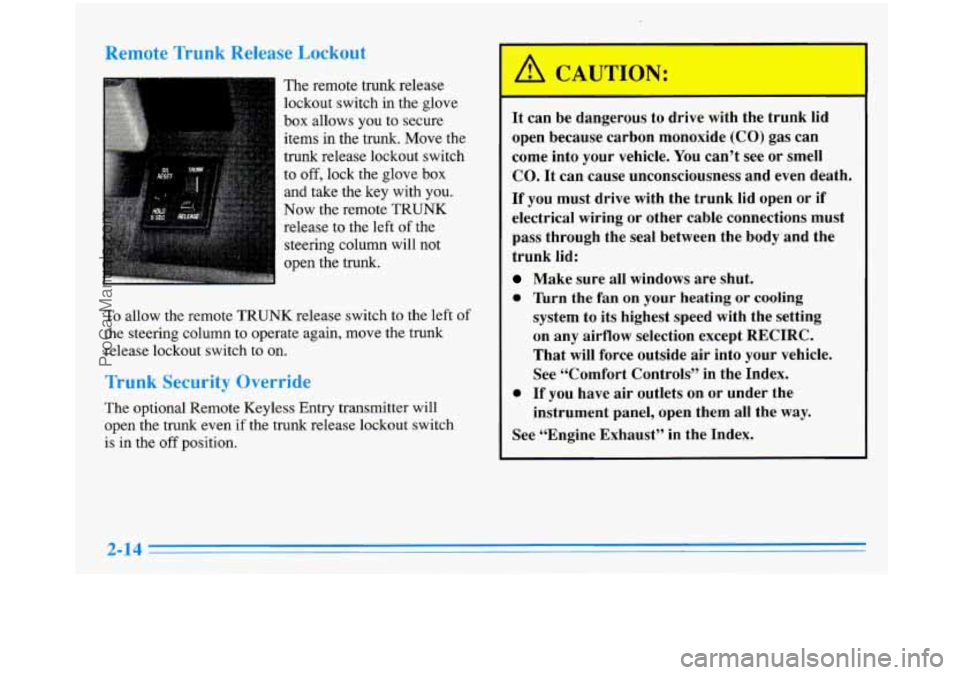
Remote Trunk Release Lockout
The remote trunk release
lockout switch in the glove
box allows you to secure
items
in the trunk. Move the
trunk release lockout switch
to off, lock the glove
box
and take the key with you.
Now the remote TRUNK
release to the left
of the
steering column will not
open the trunk.
To allow the remote TRUNK release switch to the left of
the steering column to operate again, move the trunk
release lockout switch
to on.
Trunk Security Override
The optional Remote Keyless Entry transmitter will
open the trunk even if the trunk release lockout switch
is in the off position. It can
be dangerous to drive with the trunk lid
open because carbon monoxide (CO) gas can
come into your vehicle. You can’t see
or smell
CO.
It can cause unconsciousness and even death.
If you must drive with the trunk lid open or if
electrical wiring or other cable connections must
pass through the seal between the body and the
trunk lid:
Make sure all windows are shut.
0 Wrn the fan on your heating or cooling
system to its highest speed with the setting
on any airflow selection except RECIRC.
That will force outside air into your vehicle.
See “Comfort Controls” in the Index.
0 If you have air outlets on or under the
instrument panel, open them all the way.
See “Engine Exhaust” in the Index.
ProCarManuals.com
Page 74 of 388
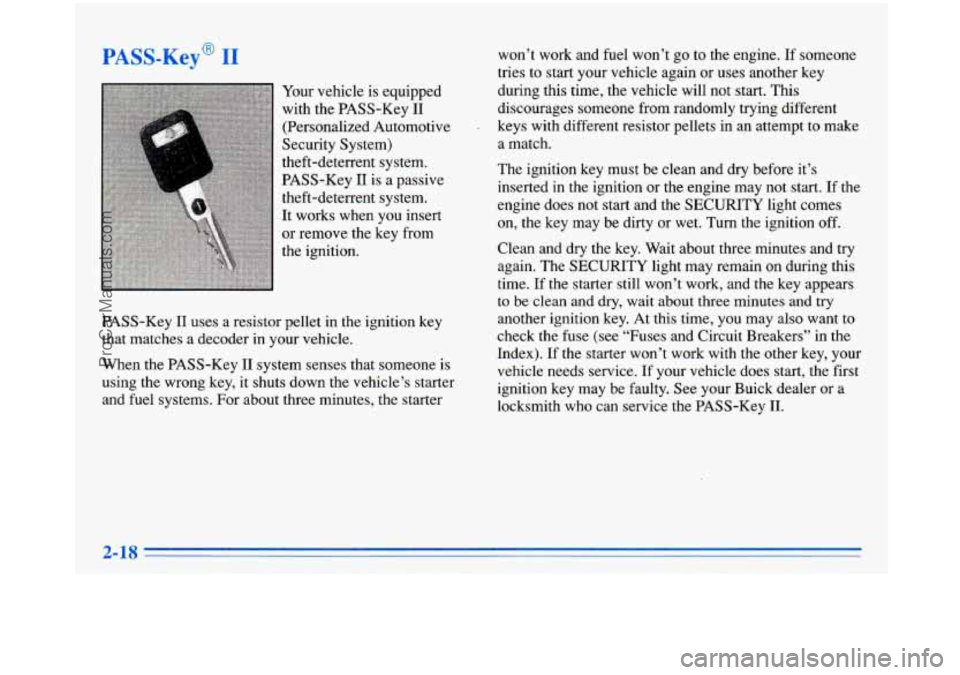
PAS7-Kej I
T
Your vehicle is equipped
with the PASS-Key
11
(Personalized Automotive
Security System)
theft-deterrent system.
PASS-Key
11 is a passive
theft-deterrent system.
It works when you insert
or remove the key from
the ignition.
PASS-Key
I1 uses a resistor pellet in the ignition key
that matches a decoder
in your vehicle.
When the PASS-Key I1 system senses that someone is
using the wrong key, it shuts down the vehicle’s starter
and fuel systems. For about three minutes, the starter won’t work and
fuel won’t go to the engine. If someone
tries to start your vehicle again or uses another key
during this time, the vehicle will not start. This
discourages someone from randomly trying different
keys with different resistor pellets in an attempt to make
a match.
The ignition key must be clean and dry before it’s
inserted in the ignition
or the engine may not start. If the
engine does not start and the SECURITY light comes
on,
the key may be dirty or wet. Turn the ignition off.
Clean and dry the key. Wait about three minutes and try
again. The SECURITY light may remain on during this
time. If the starter still won’t work, and the key appears
to
be clean and dry, wait about three minutes and try
another ignition key. At this time, you may also want to
check the fuse (see “Fuses and Circuit Breakers” in the
Index). If the starter won’t work with the other key, your
vehicle needs service. If your vehicle does start, the first
ignition key may be faulty. See your Buick dealer or a
locksmith who can service the PASS-Key
11.
ProCarManuals.com